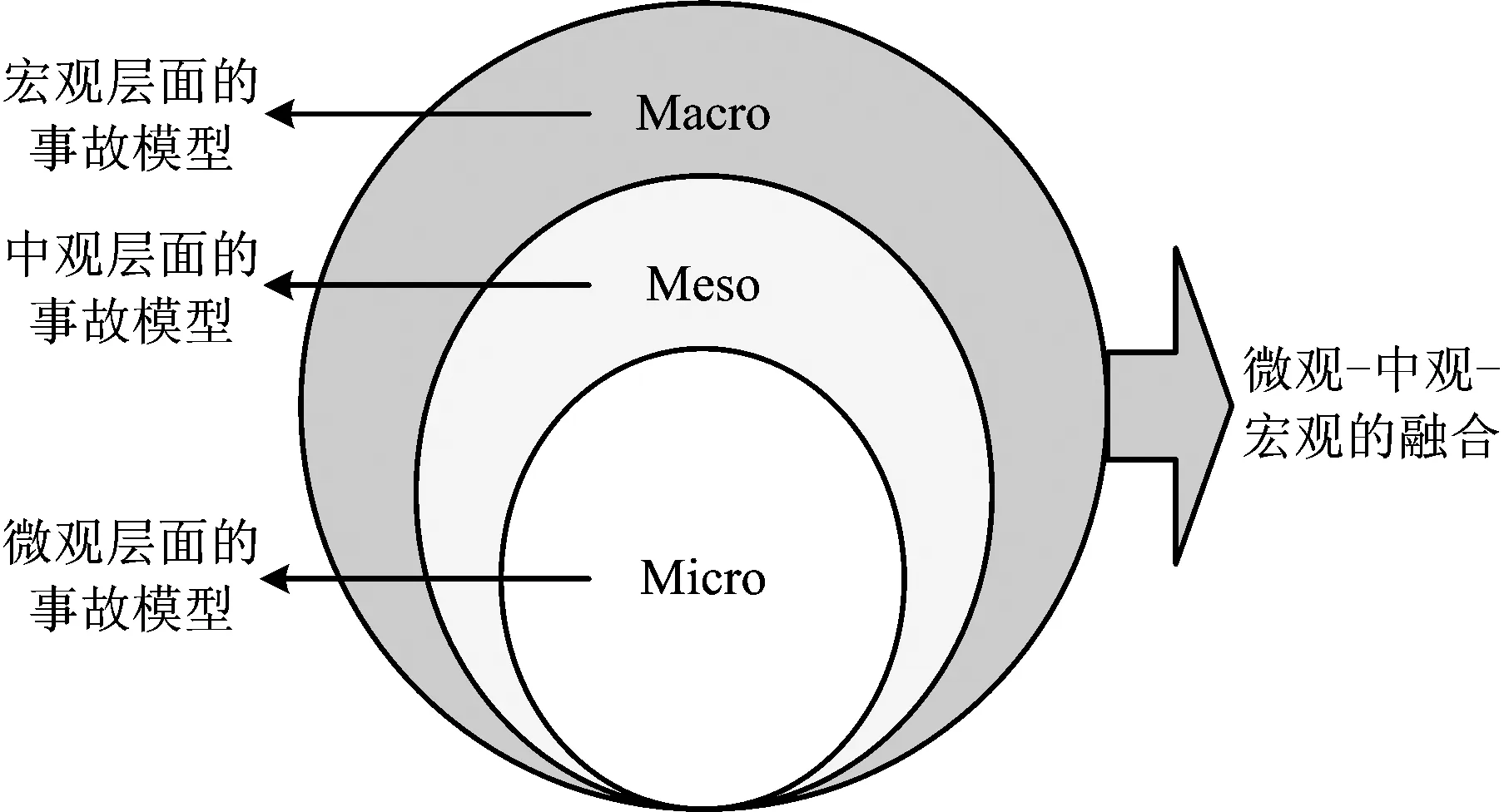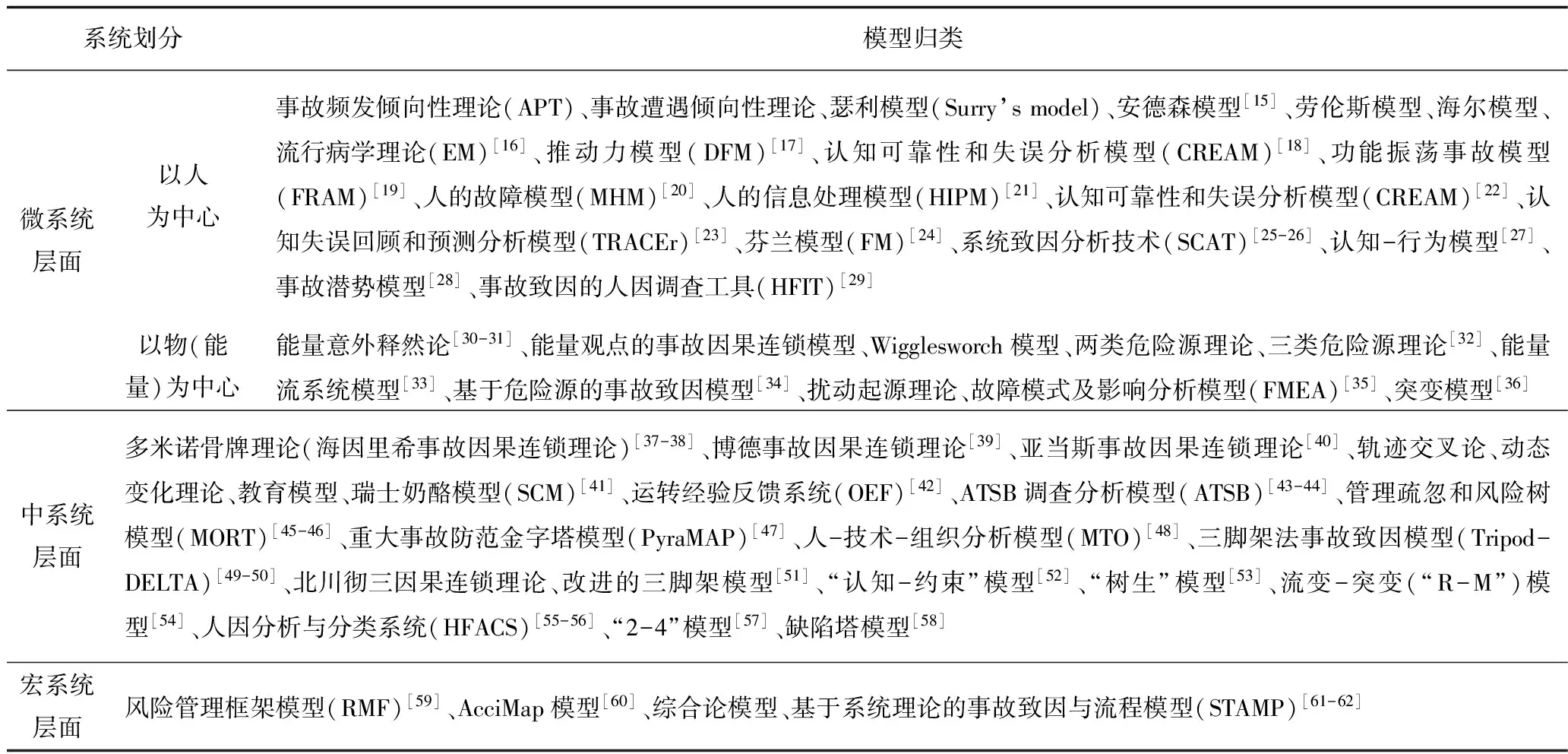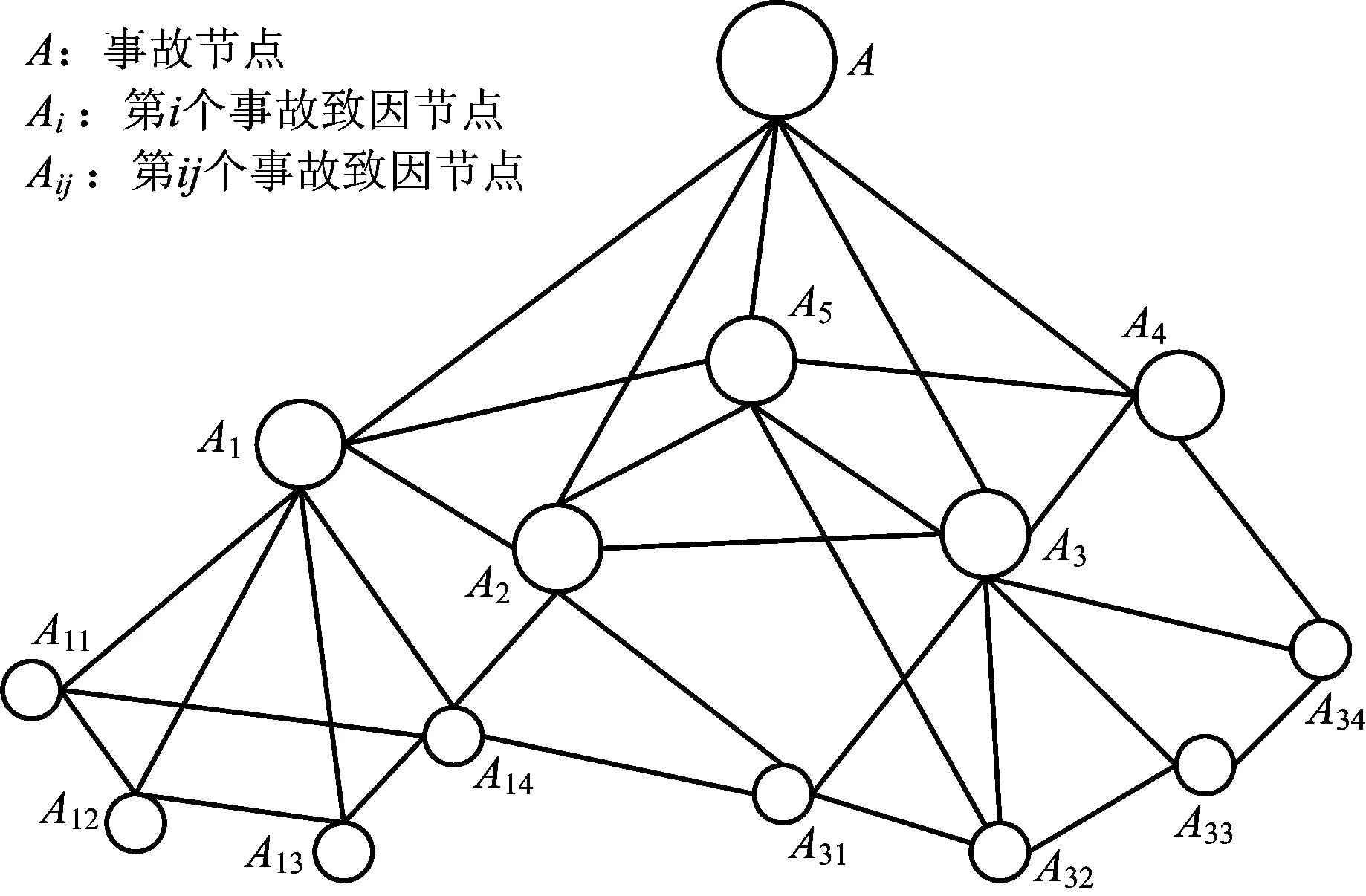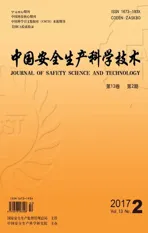事故致因模型体系及建模一般方法与发展趋势*
2017-04-14黄浪,吴超
黄 浪,吴 超
(中南大学 资源与安全工程学院,湖南 长沙 410083)
0 引言
事故致因理论是从大量典型事故调查与分析中提炼出的事故发生机理,大量研究与实践已经证明事故致因模型在安全科学理论研究与事故预防实践中的重要性,具体表现在:是事故预防与控制的理论依据,也是事故调查与分析工具;安全科学原理研究的路径之一[1],安全学是从研究生产安全事故层面发展起来的;是特定时期人们安全理念的集中反映,同时事故模型影响人们对安全的认识[2]。针对已提出的大量事故致因模型,国内学者钟茂华[3]、罗春红[4]、樊运晓[5]、魏晓阳[6],以及国外学者Sklet[7]、Swuste[8-10]等进行了一些梳理,但在时效性、系统性等方面还存在欠缺,尤其是对事故致因建模的基本问题(如方法论、结构体系等)的研究还不足。鉴于此,本文对目前国内外的事故致因模型进行总结与归纳,提炼事故致因建模的一般方法等基础性问题。在此基础上,对未来事故致因建模所遇到的挑战和发展趋势进行展望,以期为事故致因建模的研究与应用提供借鉴。
1 事故致因模型综述与分析
1.1 已有事故致因模型归类比较
吴超等[11]将安全系统划分为微观安全系统、中观安全系统和宏观安全系统;Coze[12]指出在系统安全分析和事故致因分析中,在个人层级和社会层级之间建立“微观-中观-宏观”联系属于基础理论和方法论问题;Durugbo[13]从“微观-中观-宏观”3个维度论述系统信息流建模研究现状;Yoon等[14]认为在事故分析是应该从宏观、中观和微观3个层面分析事故致因。基于此,以系统粒度为切入点,从微观、中观、宏观3个层面综述与比较事故致因模型(如图1所示):微观层面的事故致因模型主要着眼于微观安全系统,如以人或机为中心的、以人机交互为中心的事故致因模型;中观层面的事故致因模型主要着眼于中观安全系统,如以公司等组织系统为中心的事故致因模型;宏观层面的事故致因模型主要着眼于宏观安全系统,如以社会技术系统的大环境为背景的事故致因模型。对现有事故致因模型的归纳分析如表1所示。
从表1可知,现有事故致因模型主要集中在微系统层面和中系统层面,这是由生产方式的变化、人在生产过程中所处地位的变化和人们安全理念的变化决定的。
可预见的是随着科学技术的发展,宏系统层面的事故致因模型将会得到越来越多的关注,这也是面对Leveson[61]提出的技术飞速发展、事故本质发生改变、新的危险源类型的出现、系统复杂性和耦合性的提高、单类型事故容错性下降、安全需求和功能需求冲突等挑战时,新一代事故致因模型最基本的特征。

图1 安全系统的划分Fig.1 Division of safety system

表1 事故致因模型归类
1.2 事故致因的层次体系
根据上述分析及文献[52]对事故致因因素的数目与分布的论述,人们对事故致因的认识经历了从局部到系统的转变,即从系统元素到系统整体的转变。因此,以“点-线-面-体”为主线分析事故致因的结构体系(如图2所示),其中:点源事故致因模型将事故归咎于单一致因(如图2中的“A1-A”,“A2-A”等),只是从某一方面或某一角度研究事故发生规律,如早期的事故频发倾向理论和事故遭遇倾向性理论。该类模型忽略了事物间的普遍联系,因此逐渐被新的事故链模型所取代,由单一致因因素向多因素理论发展;线源事故致因模型将单个的“点源”因素视为有前后关联的事件,将事故描述为线性的链式结构(如图2中的“A11-A1-A”,“A31-A14-A1-A”等),如Heinrich提出的因果连锁模型,以及后期Bird,Adams和北川彻三改进Heinrich模型以后分别提出的事故因果连锁模型。线源事故模型从纵深方向理清了事故致因,但忽视了因素间的横向关联。此外,该类模型将“线”的末端作为事故的初始事件,这和点源事故致因模型类似;面源事故致因模型,随着系统复杂程度的提高,事故致因的范围不再局限于单一的点源或线源事故模型,而是“多点”、“多线”组成的事故致因网络,即面源事故致因模型(如图2中的“A11-A1-A”和“A31-A3-A”组成的事故致因网),如轨迹交叉模型、瑟利模型、流行病学模型、“2-4”模型等;体源事故致因模型,事故致因不再是简单的事故连,也不是同一层面的事故致因网络,而是在线源事故致因和面源事故致因的基础上,考虑不同致因链关键节点之间的横向关联,即事故致因具有等级层次结构的立体网状结构(如图2中的“A11-A1-A”,“A13-A14-A2-A”,“A31-A3-A”和“A11-A14-A31”之间的立体事故致因体系)。该类模型指出事故因素间存在递进的层次结构,这种层次结构的跃迁对应着事故的涌现过程,如综合论事故致因模型、AcciMap模型、STAMP模型等。

图2 事故致因的结构体系Fig.2 Structure system of accident-causing
2 事故致因建模的一般方法
方法是1种特定顺序或形式,即单一目的的规程或实践,方法学是研究方法、方式的综合与提炼。在事故致因建模方法方面,魏晓阳等[6]进行了初步分析,但对事故致因建模方法的提炼方面还存在欠缺。因此,笔者在对上述50余种事故致因模型归纳分析的基础上,从建模的理论基础与建模的一般方法2方面提炼事故致因建模的方法学基础性问题。事故是复杂的系统涌现现象,事故致因理论建模涉及多种建模理论,如模型轮、相似理论、系统论和系统辨识等最基本理论,还有复杂系统理论、自组织理论、网络理论、定性理论等。
基于安全科学方法学[3]的视角,通过分析与归纳现有事故致因模型的构建思路与方法,提炼事故致因建模的一般方法:相似比较法、概率统计法、推理归纳法、组合改进法、因果分析法(见表2)。
3 事故致因建模方法的发展趋势
不同的生产力发展阶段出现的安全问题不同,现有模型都是在特定的时代和特定的应用背景下提出来的,因此也就有其特定的适用范围。随着社会技术系统复杂性的提高,尤其是进入信息时代、大数据时代、工业4.0时代、人工智能时代以后,传统的事故致因模型将不能满足复杂系统事故调查与分析。因此,如何抓住科技和社会变革时机,扭转传统的事故致因建模理论、方法与技术滞后于科学技术发展的局势,提前对事故致因建模所受到的冲击和变革进行研究将会对人类的安全发展,以及安全科学学科发展带来巨大影响。
1)大数据思维与方法将对事故调查与分析、事故致因建模产生变革性影响:由于数据统计和分析方法的限制,传统的事故致因建模可能忽视或简化了一些致因因素,大数据将改变安全数据的采集、挖掘和分析方法,实现安全数据的全样本采集与分析,更加科学地揭示事故致因;传统事故致因模型注重因果关系分析和对事故的解释(解释型事故致因模型),基于大数据的事故致因建模更加注重事故现象和安全数据之间关联关系的分析;传统的事故致因模型基本都是定性分析,基于大数据的事故模型可发现事故发生的潜在规律,如事故发生的周期性、关联性、地域性、时间性等规律,使事故致因分析从定性向定量转变;传统的事故模型都是基于对已经发生的事故分析基础上构建的,尽管对预防事故具有重要意义,但通过经历事故来获取预防措施具有滞后性。大数据的核心理念是如何利用大数据进行预测,基于大数据的事故模型有助于提前、快速的识别将要发生的事故,真正做到事故的超前预防;基于大数据的事故致因模型可构建全新的安全科学分支学科(即安全大数据学),进而拓展安全科学的内涵和外延;从动态和变化的观点来分析事故致因的模型很少,不利于系统分析事故致因,基于大数据的事故致因模型可给出对事故调查分析、预测预防更为普遍和有效的方法。

表2 事故致因理论建模一般方法
2)在人工智能时代和工业4.0时代,社会技术系统越来越数字化、网络化、复杂化与智能化,将对传统的事故致因建模产生深远影响:复杂巨系统事故的多米诺效应越来越大,而这些变化都是以信息驱动为基础的,系统对信息的依赖性更强,系统信息流(信息损失、不正确信息和信息流异常流动)或信息不对称在事故致因中将越来越突出,基于“安全信息”的事故致因建模可能成为新一代的主流事故模型;传统的事故致因理论和系统安全各自发展,从不同的视角提供事故预防的手段,但二者之间缺少联系,新形势下人类的安全认识观和安全价值观将发生变化,向事故学习的观念也将发生变化;虽然系统思维已经成为社会技术系统事故分析的主导范式,认为事故是1种复杂的系统现象,但对事故的认识仍然是不完全的,社会技术系统重特大事故依然时有发生。此外,基于传统事故模型的事故调查与分析还可导致处于系统“尖底”的人或设备被不正确指责;事故性质的变化,数码技术、信息技术、互联网技术、大数据技术给大多数行业带来一场革命,带来新的系统故障模式,进而改变事故性质。例如一些应用于电器元件的传统方法(冗余),在面对使用数字技术和软件技术而导致的事故时是不充分的。冗余在某种程度增加系统的复杂性,进而增加系统风险;安全科学的研究对象和研究手段也将发生变化,事故调查与分析、事故致因建模需要跨学科、跨领域、跨部门的新研究模式。
此外,新的安全科学研究范式(如安全韧性理论、高可靠性理论、正常事故理论等)也会对对事故致因模型及其建模方法产生冲击。
4 结论
1)以系统粒度为切入点,提出以“微观-中观-宏观”为主线的事故致因模型比较分析框架,并对现有国内外已经提出的50余种事故模型进行归纳分析。
2)通过分析现有事故致因模型从系统局部到系统整体的发展沿革,提炼以“点源-线源-面源-体源”为分析主线的事故致因模型结构体系。
3)基于安全科学方法学的视角,通过分析与归纳现有事故致因模型的构建思路与方法,提炼事故致因建模的一般方法:相似比较法、概率统计法、推理归纳法、组合改进法与因果分析法,并通过实例分析,论证了所提炼方法的合理性和科学性。
4)对新形势(信息时代、大数据时代、工业4.0时代、人工智能时代)下的事故致因模型及其建模方法所遇到的挑战与发展趋势进行了分析。
[1]吴超. 近10年我国安全科学基础理论研究的进展综述[J].中国有色金属学报, 2016, 26(8): 1675-1692.
WU Chao. Some advances in safety science fundamental theories of China in the recent ten years[J]. The Chinese Journal of Nonferrous Metals, 2016, 26(8): 1675-1692.
[2]陈宝智, 吴敏. 事故致因理论与安全理念[J]. 中国安全生产科学技术, 2008, 4(1): 42-45.
CHEN Baozhi,WU Min. Etiologies of accident and safety concepts[J]. Journal of Safety Science and Technology, 2008, 4(1): 42-45.
[3]钟茂华, 魏玉东, 范维澄, 等. 事故致因理论综述[J]. 火灾科学, 1999, 8(3): 36-42.
ZHONG Maohua, WEI Yudong, FAN Weicheng, et al. Overview on accident-causing theories[J]. Fire Safety Science, 1999, 8(3): 36-42.
[4]罗春红, 谢贤平. 事故致因理论的比较分析[J]. 中国安全生产科学技术, 2007, 3(5): 111-115.
LUO Chunhong, XIE Xianping. Comparison study of accident-causing theories[J]. Journal of Safety Science and Technology, 2007, 3(5): 111-115.
[5]樊运晓, 卢明, 李智,等. 基于危险属性的事故致因理论综述[J]. 中国安全科学学报, 2014, 24(11): 139-145.
FAN Yunxiao, LU Ming, LI Zhi, et al. A review of accident modelling approaches based on components of hazards[J]. China Safety Science Journal, 2014, 24(11): 139-145.
[6]魏晓阳, 汪洋, 严新平, 等. 事故建模方法研究进展[J].中国安全科学学报, 2016, 26(3): 46-52.
WEI Xiaoyang, WANG Yang, YAN Xinping, et al. Processes in research on methods for modeling accidents[J].China Safety Science Journal, 2016, 26(3): 46-52.
[7]Sklet S. Comparison of some selected methods for accident investigation[J]. Journal of Hazardous Materials, 2004, 111(1-3):29-37.
[8]Swuste P, Gulijk C V, Zwaard W. Safety metaphors and theories, a review of the occupational safety literature of the US, UK and The Netherlands, till the first part of the 20th century[J]. Safety Science, 2010, 48(8):1000-1018.
[9]Swuste P, Gulijk C V, Zwaard W, et al. Occupational safety theories, models and metaphors in the three decades since World War II, in the United States, Britain and the Netherlands: A literature review[J]. Safety Science, 2014, 62(1):16-27.
[10]Swuste P, Gulijk C V, Zwaard W, et al. Developments in the safety science domain, in the fields of general and safety management between 1970 and 1979, the year of the near disaster on Three Mile Island, a literature review[J]. Safety Science, 2016, 86:10-26.
[11]吴超.安全科学方法学[M].北京: 中国劳动社会保障出版社, 2011: 32-63.
[12]Coze J C L. Disasters and organisations: From lessons learnt to theorizing[J]. Safety Science, 2008, 46(1):132-149.
[13]Durugbo C, Tiwari A, Alcock J. Modelling information flows for organizations: a review of approaches and future challenges[J]. International Journal of Information Management, 2013, 33(2): 597-610.
[14]Yoon Y S, Ham D H, Wan C Y. Application of activity theory to analysis of human-related accidents: method and case studies [J]. Reliability Engineering &System Safety, 2016, 150, 22-34.
[15]隋鹏程, 陈宝智, 隋旭.安全原理[M]. 北京: 化学出版社, 2005: 15-16.
[16]Gordon J E. The epidemiology of accidents [J]. American Journal of Public Health & the Nations Health, 1949, 39(4):504-15.
[17]Houston D. New approaches to the safety problem[M]. MajorLoss Prevention, 1971.
[18]Hollnagel E.Cognitive reliability and erroranalysis method[M]. Oxford: Elsevier Science, 1998.
[19]Hollnagel E. Barriers and accident prevention[M]. Hampshire: Ashgate, 2004.
[20]Rasmussen J, Pedersen O, et al.Classification system for reporting events involving humanmalfunctions[M]. Ispra, Italy: Joint Research Centre,1981.
[21]Wickens C. Engineering psychology and human performance[M]. New York: HarperCollins, 1992.
[22]Hollnagel E. Cognitive reliability and error analysis method[M]. Oxford: Elsevier, 1998.
[23]Shorrock S, Kirwan B. Development and application of a human error identification tool for air traffic control[J]. Applied Ergonomics, 2002, 33(4):319-36.
[24]Tuominen R, Saari J. A model for analysis of accidents and its application[J]. Journal of Occupational Accidents, 1982, 4(2-4):263-273.
[25]Emery L W, Mungan N, Nicholson R W. Systematic cause analysis technique (SCAT) Manual.(OH Literature Digest)[J]. Journal of Petroleum Technology, 1970, 22(12):1569-1576.
[26]CCPS, Guidelines for Investigating Chemical Process Incidents[M]. Center for Chemical Process Safety of the American Institute of Chemical Engineers, 1992, ISBN 0-8169-0555-X.
[27]赵宝柱, 沈廷萍,刘如民. 个人因素事故致因模型的探讨[J]. 安全与环境工程, 2004, 11(1): 80-83.
ZHAO Baozhu,SHEN Tingping, LIU Rumin. Discussion on the model of accident phenomenon attributes to personal factors[J]. Safety and Environmental Engineering, 2004, 11(1): 80-83.
[28]袁大祥, 柯丹丹. 事故的系统论[J]. 系统工程学报, 2004, 19(2): 183-186.
YUAN Daxiang, KE Dandan. System theory of accident[J].Journal of Systems Engineering, 2004, 19(2): 183-186.
[29]Gordon R, Flin R,Mearns K. Designing and evaluating a human factorsinvestigation tool (HFIT) for accident analysis[J]. Safety Science, 2005, 43(3):147-171.
[30]Gibson JJ. The contribution of experimental psychology to the formulation of the problem of safety-a brief for basic research. In behavioral Approaches to Accident Research. New York, NY: Association for the aid of Cripple Children. 1961: 77-89.
[31]Haddon W. A note concerning accident theory and research with special reference to motor vehicle accidents[J]. Annals of the New York Academy of Sciences, 1963, 107(2): 635-646.
[32]田水承, 李红霞, 王莉. 3类危险源与煤矿事故防治[J]. 煤炭学报, 2006, 31(6): 706-710.
TIAN Shuicheng, LIHongxia, WANG Li. Three types hazard theory and prevention of coalmine accidents[J]. Journal of China Coal Society, 2006, 31(6): 706-710.
[33]黄浪, 吴超, 杨冕, 等. 基于能量流系统的事故致因与预防模型构建[J]. 中国安全生产科学技术, 2016, 12(7): 55-60.
HUANG Lang, WU Chao, YANG Mian, et al. Modeling of accident causing and prevention based on energy flow system[J]. Journal of Safety Science and Technology, 2016, 12(7): 55-60.
[34]孟现飞, 张炎治, 宋学锋, 等. 基于危险源的事故致因机理及两极化管理[J]. 中国安全科学学报, 2011, 21(9): 34-38.
MENG Xianfei, ZHANG Yanzhi, SONG Xuefeng, et al. Accident causation mechanism and polarized management based on hazards[J]. China Safety Science Journal, 2011, 21(9): 34-38.
[35]Bowles J B, Peláez C E. Fuzzy logic prioritization of failures in a systemfailure mode, effects and criticality analysis[J]. Reliability Engineering & SystemSafety, 1995, 50: 203-213.
[36]钱新明, 陈宝智. 事故致因的突变模型[J]. 中国安全科学学报, 1995, 5(2): 1-4.
QianXinming, Chen Baozhi. The catastrophe model for accident-causion[J].ChinaSafetyScienceJournal, 1995, 5(2): 1-4.
[37]Heinrich H W, Petersen D, Roos N. Industrial accident prevention-a safety management approach[M]. New York:McGrawHill, Inc, 1980: 22-25.
[38]Heinrich H.W. Industrial accident prevention[M]. New York: McGraw-Hill, 1931.
[39]Frank E Bird. Management guide to loss control[M]. Atlanta:Institute Press, 1974: 5-50.
[40]Adams J. The management of risk and uncertainty [J]. Policy Analysis, 1999, 355(1): 1-49.
[41]Reason J.Human Error[M]. New York Cambridge: University Press,1990.
[42]Dechy N, Dien Y, Funnemark E, et al.Results and lessons from the ESReDA’s accident investigation working group [J].Safety Science, 2012,50(6):1380-1391.
[43]Australian Transport Safety Bureau. Analysis, causality and proof in safetyinvestigations. Aviation Research and Analysis Report AR-2007-053.AustralianCanberra City:Transport Safety Bureau, 2008.
[44]Underwood P, Waterson P. Systems thinking, the Swiss Cheese Model and accident analysis: A comparative systemic analysis of the Grayrigg train derailment using the ATSB, AcciMap and STAMP models[J]. Accident Analysis & Prevention, 2014, 68(1):75-94.
[45]Johnson W.G. The Management Oversight and Risk Tree-MORT including Systems Developed by the Idaho Operations Officeand Aerojet Nuclear Company. Available from: www.nri.eu.com, the website of the Noordwisk Risk Initiative, 1973.
[46]Johnson W.G. MORT Safety assurance systems, Marcel Dekker,New York, USA, 1980.
[47]Bellamy L J, Geyer T A W, Wilkinson J. Development of a functional model which integrates human factors, safety management systems and wider organizational issues[J]. Safety Science, 2008, 46(3):461-492.
[48]Bento J.P.MTO-analysavhändelsesrapporter, OD-00-2, Oljedirektoratet, Stavanger, 1999.
[49]Hudson P T W, Reason J T, Bentley P D, et al. Tripod delta: proactive approach to enhanced safety[J]. Journal of Petroleum Technology, 1994, 46(1):58-62.
[50]J REASON. Driving errors, driving violations and accident involvement[J]. Ergonomics, 1995, 38(5):1036-1048.
[51]刘燕, 庄越. 三脚架事故致因模型的结构化重构研究[J], 中国安全科学学报, 2016, 26(4): 60-66.
LIU Yan, ZHUANG Yue. A study on structural reconstruction of Tripod-DELTA[J].China Safety Science Journal, 2016, 26(4): 60-66.
[52]王瑛, 汪送, 管明露. 复杂系统风险传递与控制[M]. 北京: 国防工业出版社, 2015: 16-25.
[53]冯庆善. “树生”事故致因理论模型[J]. 油气储运, 2014(2):115-120.
FENG Qingshan.“Tree type” model of accident cause theory[J].Storage and Transportation of Oil and Gas, 2014(2):115-120.
[54]何学秋, 马尚权.安全科学的“R-M”基本理论模型研究[J]. 中国矿业大学学报, 2001, 30(5): 425-429.
HEXueqiu, MA Shangquan.Research on model of“R-M” theory in safety science[J]. Journal of China University of Mining& Technology, 2001, 30(5): 425-429.
[55]Wiegmann DA, Shappell SA. A Human error approach to aviation accidentanalysis: the human factors analysis and classification system[M]. Aldershot:Ashgate; 2003.
[56]Li W C, Harris D. Pilot error and its relationship with higher organizational levels: HFACS analysis of 523 accidents[J]. Aviation Space & Environmental Medicine, 2006, 77(10):1056-1061.
[57]傅贵,殷文韬, 董继业, 等.行为安全“2-4”模型及其在煤矿安全管理中的应用[J]. 煤炭学报, 2013, 38(7): 1123-1129.
FU Gui, YIN Wentao, DONG Jiye, et al. Behavior-based accident causation: the“2-4”model and its safety implications in coal mines[J]. Journal of China Coal Society, 2013, 38(7): 1123-1129.
[58]范秀山. 事故致因理论: 缺陷塔模型[J]. 中国安全科学学报, 2012, 22(2): 3-9.
FAN Xiushan. Fault tower model as an accident causation theory[J]. China Safety Science Journal, 2012, 22(2): 3-9.
[59]Rasmussen J. Risk management in a dynamic society: a modeling problem[J].Safety Science, 1997, 27(2/3): 183-213.
[60]Svedung I, Rasmussen J. Graphic representation of accident scenarios: mapping system structure and the causation of accidents[J]. Safety Science,2002, 40(5),397-417.
[61]Leveson N. A new accident model for engineering safer systems[J]. Safety Science, 2002, 42(4):237-270.
[62]Leveson N. Applying systems thinking to analyze and learn from events[J]. Safety Science, 2011, 49(1):55-64.
